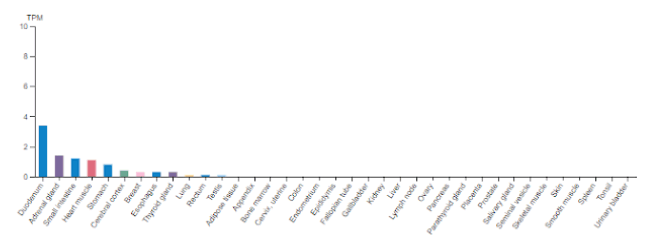Growth hormone releasing hormone (GHRH) is a naturally occurring peptide released by nerves, called arcuate neurons, in the hypothalamus. The peptide travels from the hypothalamus to the pituitary gland where it binds to the growth hormone releasing hormone receptor and causes the release of growth hormone (GH). GHRH is critical for proper growth and development, increasing lean body mass and reducing adiposity (fat tissue). GHRH is indirectly responsible for muscle growth and long bone growth, but has also been found to regulate inflammation, mitigate pain, and play an important role in the sleep-wake (diurnal cycle). It is released in a pulsatile manner from the hypothalamus and thus causes the pulsatile release of GH as well. This pattern of release is important to the function of growth hormone and thus to physiology in general.
GHRH, unlike other hormones, can exist in several forms. In fact, its size can range from 37 to 44 amino acids, with the 44-amino-acid version be the most common and the standard reference when discussing GHRH. Interestingly, these changes in size have no effect on overall function of the peptide as far as experimental evidence can discern and so the 37-amino-acid long version produces the same effects as its longer counterpart.
GHRH has a basal rate of release that varies with age and developmental status, but the pattern of pulsatile release remains regardless of the baseline level of the hormone. Research indicates that preserving the natural pulsation of GHRH, even during exogenous administration, is important to preserving normal physiology and preventing certain side effects.
GHRH differs from other hormones because, within the central nervous system, GHRH is found exclusively in the hypothalmus. While many hormones are widely distributed throughout the CNS, GH is not. GHRH is found, however, in peripheral tissues like the pancreas, heart, thymus, and colon[1]. It has also been found, pathologically, in certain tumors.

A number of analogues of GHRH have been developed in an effort to target some of the peptide’s effects while avoiding other properties. Alterations have also been made in order to to prolong the half-life of exogenously administered GHRH. Examples of GHRH analogues include CJC-1295, Sermorelin, and Tesamorelin. Tesamorelin was approved by the FDA in 2010 for the treatment of lipodystrophy (abnormal deposition of fat) in HIV.
GHRH, by stimulating GH release, is a potent muscle-building peptide and anti-obesity peptide. GH promotes the development of lean body mass, and supplementation with GHRH has been shown to do the same. Interestingly, research indicates that obesity causes a decrease in circulating levels of GH by affecting GHRH secretion[9]. Scientists have long known that increased obesity makes it harder to lose weight and affects everything from appetite to the way the body absorbs calories (obesity actually makes the body more efficient at absorbing calories). Now it appears that at least part of this anomaly results from a decrease in GHRH secretion in obesity. In other words, the more adipose tissue the body accumulates, the more GHRH secretion is reduced and the harder it is to lose weight. Scientists speculate that GHRH (or GHRH analogue) supplementation may be an effective means of jump starting weight loss until the cycle can be broken and endocrine regulation can be reestablished.
It has long been known that GHRH secretion is suppressed in response to both physical and emotional stress. In fact, careful studies have shown that stress, even psychological stress, can lead to delayed puberty, short stature, and depression. These changes in development can be directly linked to changes in GHRH levels, but the exact mechanism by which stress affects GHRH has been unclear until recently. New research suggests that the change in GHRH secretion is a result of neuropeptide Y levels, which actually cause changes in the neurons responsible for GHRH production and release. It is thought that the change in GHRH release is designed to help preserve energy by restricting growth during times of famine. Unfortunately, this system is activated during any stressful event and prolonged stress, particularly during childhood, can lead to severe restriction of development[10]. There is some question as to whether GHRH supplementation might be indicated for individuals with severe physical and emotional distress so as to offset the negative effects on growth, development, inflammation, and cognition.